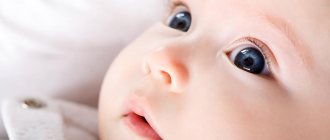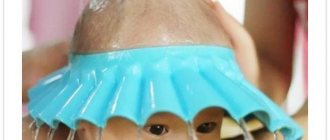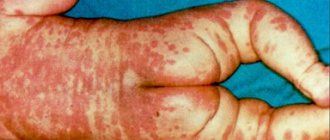Causes of purulent discharge from the eyes in children
Eye diseases that can cause purulent discharge from the eyes in newborns and infants:
Dacryocystitis of newborns
Many children are born with poorly developed tear ducts. This means that tears cannot drain properly into the nasal cavity. Because of this, secretions from the eyes accumulate in the lacrimal sac and inflammation begins. In this case, as a rule, only one eye of the baby becomes watery and purulent.
Treatment in the first 3 months of the child is carried out with medication. Anti-inflammatory drops are instilled and massage of the lacrimal sac is applied. In most cases, dacryocystitis goes away. Sometimes it is necessary to probe the lacrimal ducts.
Neonatal conjunctivitis
Inflammation of the mucous membrane of the eye during the period 28 days after birth is called neonatal conjunctivitis.
Bacteria that cause inflammation: Staphylococcus aureus, chlamydia, streptococcus, etc.
Gonococcal infection of newborns
With gonococcal infection, newborns have very profuse purulent discharge, with pronounced swelling of the eyelids. Damage to the cornea and development of corneal ulcers may occur.
Eye injury during childbirth
In case of pathological birth, eye damage and infection of the eye are possible.
Inadequate eye care immediately after birth
Immediately after birth, newborns are given special antiseptic drops for prevention. In the case when drops are not used, the risk of developing conjunctivitis in newborns is increased.
Inflammation of the mother's genital tract
Inflammation of the mother's genital tract leads to infection of the child and the appearance of signs of eye inflammation.
Causes of eye suppuration in children
There are many different reasons why a child's eyes may fester. Some of them may be associated with poor hygiene; this condition is easily treated. Others require complex therapy because the cause is a disease.
Violation of hygiene rules
Due to their young age, children can often violate hygiene rules. This item includes not washing your hands frequently, not washing your face in the morning and evening, and rubbing your eyes in public places with dirty hands.
This point also includes wearing contact lenses inappropriately by older children. They may forget to change the solution, use a dirty container, or fail to wash their hands before putting in and taking out lenses.
Gradually, bacterial microflora accumulates in the child’s eyes, which releases toxins and waste products. All this together leads to the formation of suppuration.
Bacterial conjunctivitis
This is a condition in which the child's conjunctiva becomes inflamed due to an increase in the amount of bacterial microflora. As a result, he develops not only suppuration in the inner corner of the eye, but also inflammation, swelling, increased tearing, and photophobia. The most characteristic symptom of bacterial conjunctivitis is eyelashes sticking together in the morning.
As a result, the child cannot open his eyes until he washes himself.
Frequent body infections
If a viral or bacterial agent that causes a disease often appears in the human body, this leads to a decrease in immune function. It becomes weakened, so immune cells are not formed immediately.
The condition causes any negative environmental factor to lead to changes in the eyes. This could be hypothermia, exposure to bright sun, swimming in the sea or pond.
Secondary infection
When allergic, viral, mechanical conjunctivitis develops in a child, treatment does not begin immediately. The result is severe irritation and an inflamed eye. This leads to the activation of opportunistic microflora, the number of which begins to increase. A secondary bacterial infection forms with the formation of pus.
Dacryocystitis
A condition in which the lumen of the tear duct becomes blocked or narrowed. This causes bacteria to begin to accumulate in the lacrimal sac. It becomes inflamed and suppuration forms. As a result, the child develops chronic bacterial conjunctivitis, the absence of tears or their presence for no particular reason.
If the blockage is not removed in time, stones will gradually form in the duct and it will completely block.
The emergence of a new infection
This type includes conjunctivitis, which is not caused by streptococcus or staphylococcus. These microorganisms are a component of opportunistic microflora. The new infection contains bacteria that appeared initially in the eyes. This is the most dangerous for the patient; such microorganisms have increased virulence. It could be pneumococcus, gonococcus, chlamydia.
Bacteria are quite difficult to remove; this requires certain groups of antibiotics. It is recommended to do a culture to identify the microorganisms that cause the disease, as well as the antibiotic that has an effect on it.
Causes of purulent discharge from the eyes in pregnant women and children over one year old
ARVI and influenza
Pus that may be present in your child's eyes may be due to a viral infection. Knowing the causative factors, as well as how to cope with them, can prevent the development of purulent discharge from the eyes in an infant.
Sinusitis
If your baby has a cold, he may develop sinusitis (inflammation of the sinuses). Important symptoms: fever, pain in the forehead and eyes, lacrimation and suppuration of the eyes.
Allergy
If your baby has a runny nose and you notice redness and small mucous-yellow discharge, then it may be an allergy.
Conjunctivitis
The eyes of children and pregnant women often fester due to infectious inflammation. Inflammation can be caused by both bacteria and viruses. Symptoms of conjunctivitis begin in one eye and then spread to the other eye.
Symptoms of cold conjunctivitis in children
Adenovirus infection is characterized by symptoms that appear simultaneously: an increase in temperature above 38 degrees, redness of the throat and the development of conjunctivitis in the eyes. This form of the disease is very contagious and can cause severe complications on the visual organs. In addition, with cold conjunctivitis, a 3-year-old child experiences swelling and hyperemia of the conjunctiva, inflammation of the lymph nodes near the ears, and lacrimation.
Rashes on the eyelids in the form of watery blisters, sharp pain in the eyes, photophobia are characteristic signs of the herpetic form of pathology. In this case, you need to consult a doctor promptly, since the herpes virus is one of the most dangerous in terms of damage to the visual organs in children.
Sometimes viral conjunctivitis in a child may be accompanied by bacterial conjunctivitis, accompanied by purulent discharge from the eyes. The duration of treatment in this situation will be longer.
A child's eye is festering, treatment
Situations that require immediate attention and medical attention include the following symptoms:
- severe swelling of the eyelids and very profuse purulent discharge
- increase in body temperature
- the child complains of decreased vision and pain in the eyes
- child rubs his eye
- eye redness and watery eyes
It is important to know that the spread of infection in children occurs very quickly and rapidly. Therefore, it is necessary to seek medical help in a timely manner.
During treatment, when using eye ointments and drops, it is necessary to first remove pus from the eye. Any types of medications (drops and ointments) are effective only after rinsing the eye.
How to treat pus in a child's eyes
It is not recommended to treat a 1-12 month old child on your own. The specialist must take into account the individual characteristics of the baby before prescribing effective therapy, especially if the cause of suppuration is viral or bacterial infections. If purulent processes develop in the spring, then most likely it is allergic conjunctivitis, so antihistamines are needed. Infectious pathologies are treated with antibacterial ointments, and if the eyes of a month-old baby are festering due to dacryocystitis, then only a special massage will help.
First aid
It is not always possible to see a doctor, so if the eyeball is red, runny, swelling of the mucous membrane and purulent discharge from the child’s eye, it is necessary to provide him with first aid:
- If after sleep the baby cannot open the eyelid, the crusts need to be softened. To do this, a cotton swab should be soaked in a warm 0.2% solution of furatsilin, a weak solution of potassium permanganate, weak tea or herbal decoction. Irrigation stimulates the opening of the optic ducts.
- After washing the eye, you need to drip it with a 10% solution of albucid. To do this, the lower eyelid should be pulled back and the pipette should be directed to the outer corner.
- Warm herbal infusions and tea for rinsing can be used every 2 hours. Use drops for instillation 4-6 times a day.
- It is contraindicated to further treat the baby on your own. Treatment with antibiotics without a doctor's prescription is prohibited.
- Salt lamp - benefits and harm. How to choose a salt lamp and instructions for use
- Children's birthday menu with recipes
- Fitness classes at home for weight loss
How to wash a child's eyes
Treating a child is a responsible and serious matter. If pus begins to accumulate in the baby’s eyes, dried chamomile or calendula flowers are suitable for washing them. Infusions are easy to prepare. To do this, put 1.5 tbsp in a 200 ml bowl. l. chamomile, calendula or a mixture of plants purchased at the pharmacy. Then fill it with boiling water to the brim, cover with a lid and let it brew for two hours. The temperature of chamomile decoction for instillation into a child’s eyes should not exceed 37 degrees.
Drug treatment
Suppuration of the eyes requires immediate treatment. Initially, the doctor prescribes drug therapy, which is based on the causes of the pathology. If the medications do not give a positive result, and the child’s eyes constantly fester, then surgical intervention is required. For conjunctivitis, the doctor may prescribe the following medications:
- Acyclovir (tablets). The drug helps with viral infections caused by herpes. The recommended dose for children over 2 years of age is 200 mg 5 times a day for 5 days. In case of overdose, adverse reactions are possible in the form of nausea, vomiting, headaches, and confusion.
- Levomycetin (alcohol solution). A topical antimicrobial that is used for bacterial eye infections. Children over 1 year of age are prescribed 2-3 drops 1-2 times a day. The doctor prescribes the duration of the course individually. Sometimes allergic reactions develop in children in the form of eye burning and itching.
Drops for pus in the eyes
Drops are prescribed to children for inflammation, when the eyes are watery and sticky due to pus flowing from them. The drugs are produced in the form of a solution placed in a special dropper bottle. Depending on the pathogen, eye drops may belong to the antibacterial or antiviral group. Most drugs have anti-inflammatory, antiallergic, analgesic and immunomodulatory properties. Popular drugs for children:
- Torbex. Broad-spectrum antibiotic of the aminoglycoside group. Prescribed for the treatment of conjunctivitis for children over 1 year of age. Rarely used for infants. Recommended dosage is 1 drop 5 times a day. Duration of treatment – 1 week. If the dose is exceeded, there is a danger of deterioration in kidney function and the development of muscle paralysis.
- Phloxal. Antibacterial drops that provide a lasting and rapid therapeutic effect. Children's dosage – 1 drop every 6 hours for 14 days. Treatment should not be interrupted after symptoms disappear.
Eye ointments
There are many ointments for the treatment of eye diseases. They are used depending on the causative agent of the disease. It is easy to find non-steroidal antimicrobial, steroidal hormonal, antihistamine and combined topical medications on sale. The following drugs are most often prescribed for the treatment of childhood eye diseases:
- Florenal ointment. Suppresses the proliferation of viruses that cause damage to mucous membranes. Apply the ointment behind the eyelid 2 times a day, morning and evening. The duration of treatment depends on the degree of infection by the virus. In advanced stages of adenovirus, the ointment is used for 1-2 months. The drug should not be used by children with hypersensitivity to its components.
- Tetracycline ointment. A broad-spectrum antibiotic prescribed for children over 8 years of age. The recommended dosage for eye infections is to apply the ointment under the lower eyelid 3 to 5 times a day. Duration of use – from 3 to 30 days. The ointment is contraindicated for use in cases of abnormal blood composition, liver and/or kidney dysfunction.
Special massage
For dacryocystitis, ointments, drops and eye washes will not bring a therapeutic result. To improve the condition, you must first remove the film using a special massage, the technique of which should be shown to the parents by a doctor. Before performing the procedure, you should wash your hands thoroughly and ensure that your nails are trimmed. Using your finger up and down, you should massage the inside of your baby's eye very gently. 6-10 movements are done in one session. If there is a lot of pus coming out of the lacrimal sac, it means that the procedure is being performed correctly.
Allergic conjunctivitis in a child
Allergies in modern society are a fairly common phenomenon. This is facilitated by widespread deterioration of the environmental situation, weakening of human immunity due to a sedentary lifestyle, unhealthy diet and other reasons. Children's conjunctivitis can be caused by various allergens: flowering plants, household chemicals, animal hair and fluff, various foods or medications. As soon as the irritant hits the mucous membrane of the child’s eyes, signs characteristic of allergic conjunctivitis appear:
- itching, irritation, lacrimation;
- redness and swelling of the eyelids;
- photophobia, cough, runny nose.
Allergic conjunctivitis is also called “red eye disease.” It usually affects both visual organs. How to treat allergic conjunctivitis in a three-year-old child? For each drug there are age restrictions (for example, it is often prohibited for treating children under 2-3 years of age). For small children, drops that relieve swelling and irritation are suitable: Visine, as well as antihistamines Allergodil, Alezastin, Olopatadine. They help reduce allergic manifestations.









